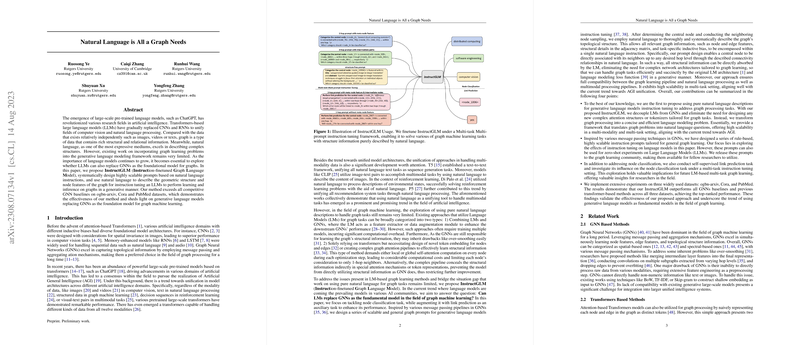Insightful Overview of "Language is All a Graph Needs"
The paper "Language is All a Graph Needs" introduces InstructGLM, an innovative framework that positions LLMs as a potential foundation for graph machine learning. This work addresses a notable gap in the integration of graph data within the LLM paradigm, proposing a novel approach to utilizing natural language as a means to encode graph structures and facilitate graph-related tasks such as node classification and link prediction.
Key Contributions and Methodology
- Unified Framework for Graph Learning: InstructGLM leverages the expressive capacity of natural language to describe complex graph structures. By utilizing natural language prompts, the paper proposes a method to perform graph learning tasks that traditionally relied on Graph Neural Networks (GNNs). This approach enables the application of LLMs to graph data without necessitating intricate graph-specific modifications to the underlying models.
- Instructional Prompts: The framework introduces carefully designed natural language prompts that encode structural graph information. These prompts vary by incorporating node and edge features and range from simple 1-hop connections to more complex multi-hop relationships. This flexibility allows InstructGLM to efficiently capture graph topology and semantic content without iterative message passing inherent to GNNs.
- Generative Instruction Tuning: The method employs instruction tuning, aligning graph learning tasks with LLMing objectives. This involves using LLMs to generate responses for graph tasks based on natural language descriptions of graph structures—an approach that harmonizes well with the multimodal capability of modern LLMs.
- Self-Supervised Link Prediction: As an auxiliary framework component, self-supervised link prediction is employed to enhance the model's understanding of graph connectivity, thereby improving node classification performance. This auxiliary task demonstrates the model's ability to leverage shared learning across graph tasks.
Experimental Results
InstructGLM is tested on standard graph datasets (ogbn-arxiv, Cora, and PubMed), achieving performance superior to traditional GNN baselines and prior Transformer-based models. On ogbn-arxiv, InstructGLM with Llama-7b backbone surpassed the best GNN baseline by 1.54% in accuracy, highlighting the promising potential of LLMs in graph learning. Similarly, improvements on Cora and PubMed confirm the method's efficacy across varied datasets.
Implications and Future Directions
The research presented in this paper has significant implications for the future of graph machine learning. By reframing graph tasks within the LLM paradigm, it aligns well with the ongoing trend in AI towards unifying model architectures across modalities. This could simplify and enhance the efficiency of developing models capable of understanding and leveraging diverse data types concurrently.
Practically, this approach could lead to the development of more robust and scalable AI systems capable of integrating vision, language, recommendation, and graph analysis into a single framework, thereby advancing toward the goal of AGI.
Future advancements may include:
- Enhancements in neighbor sampling strategies to better accommodate large-scale graphs.
- Exploration of the application of LLMs to even more complex graph-related tasks.
- Incorporating additional modalities into the InstructGLM framework, pushing towards a more holistic AI understanding across diverse domains.
In conclusion, the paper "Language is All a Graph Needs" presents a compelling argument for the use of natural language as an intermediary for graph learning. It not only signifies a pivotal shift in how we approach cross-domain AI modeling but also establishes a foundation on which future innovations can be built.
